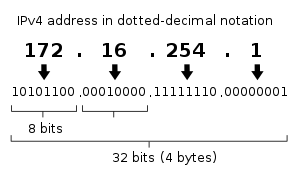Effective communication on a network usually requires that every participant of the network can be clearly identified and singled out from others. Computers on a network need to clearly specify a target receiver during the transfer of data. Every computer linked to a network has a unique identifier called an "IP address". The IP (Internet Protocol) address is used for network interface identification and location addressing. There are two popularly used versions of the internet protocol. The Internet protocol version 4 and the internet protocol version 6. IPv4, the Internet Protocol version 4 defines a 32-bit number. It consists of four sets of 8-bit numbers separated by decimal points. An example of a IP address is 172.16.254.1.

The IPv4 was depleted because of the growth of the internet. The IPv4 could only produce addresses for 4.3 billion computers (2^32). The IPv6 was introduced to replace the already depleted IPv4. The IPv6 defines a 128-bit number. The IPv6 is represented by eight groups of four hexadecimal digits separated by colons. The main advantage IPv6 has over IPv4 is its larger address space. The IPv6 address is a 128-bit number. This means it can produce unique addresses for 340,282,366,920,938,463,463,374,607,431,768,211,456 devices (2^128). An example of the IPv6 address is 2001:db8:0:1234:0:567:8:1.
The IP address though a great way for computers to be uniquely identified over the internet, leaves us with an issue. The issue is that this numbers are not human readable. Human beings find it difficult to remember these numbers. An alias of the IP address was created to provide a more human readable way of identifying computers. This alias is known as the domain name.
The Domain Name
The domain name is an alias that indicates where a web resource can be found. The domain name usually appears in a form similar to "example.com" .
The domain name can be divided into :
- Top level domain (.com)
- Second level domain (example)
- Third level domain (www.)
Top Level Domain
The Top level domain (TLD) indicates the general purpose behind the domain. Example of TLDs are, .com, .net, .org, .ng, .gov, .edu. Certain TLDs are strictly to be used by organizations in a certain industry so its clearly indicates the purpose behind the domain. Some require the service to be provided in a given language or hosted in a certain country. The .gov TLD is used only by government institutions, .edu is used by educational institutions. Some TLDs are country specific like .ng specific to organizations in Nigeria, .co.uk for the UK, .fr for France. The TLD has a maximum length of 63 characters.
Second Level Domain
The second level domain is a case sensitive label and has a maximum length of 63 characters. It can contain alphabets(A-Z), numbers(0-9) and the "-" character. They commonly refer to the name of the organization that registered the domain.
Domain names can be gotten from domain registers. The domain name registrar, gives an individual or organization right to a particular domain. Examples of domain registrars include, GoDaddy and Bluehost.
THE DOMAIN NAME SYSTEM.
The domain name system(DNS) is a system whose job is to translate domain names into numerical IP addresses needed for locating and identifying devices on the internet. Domain name system can be likened to a phone book that matches domain names to IP addresses. The IP addresses are the numbers the computers use in identifying and communicating with each other. The domain name system is a directory that is distributed in different regions around the world, stored on servers that communicate with each other.
There are four types of domain name system servers
- Root Name Servers
- Top Level Domain Name Server
- Authoritative Domain Name Server
- Recursive Domain Name Server or Resolvers.
RESOLVERS: the resolvers are servers used by the internet service provider to send a request to other DNS servers. When a client requests for the IP address of a domain the resolver breaks up the domain into its different component and makes appropriate request with each component.
ROOT NAME SERVERS: They are servers at the root of the domain system hierarchy. They are name servers that replies a request with a list of all authoritative name servers associated with a particular TLD (Top Level Domain). This is the first step in transforming the human readable domain name into an IP address. When a client request a domain name, the resolver breaks up the domain into its components and queries the TLD component against the root name server. When a resolver is queried with a domain name say "example.com". The root name server is queried with ".com" to return the Top Level Domain authoritative sever responsible for the .com TLD.
TOP LEVEL DOMAIN SERVER: They are servers that store the name and address to all authoritative servers associated with a top level domain. A Top Level Domain Server queried with a domain like "example.com" returns the IP address of the authoritative server associated to that domain. It basically returns the IP address of the server responsible for the "example.com" domain.
Authoritative Name Server: Authoritative servers are servers responsible for rendering particular web resources. You can get the authoritative server to a particular website by tying in this command in you command window.
- in your CMD enter "nslookup"
- Enter the command "set query=ns".
- Type in the domain name whose server you wish to see e.g "example.com"
How does a client load a web resource?
when a user types in a URL, the browser sends the URL to the operating system of the computer. The operating system sends the URL to the DNS resolver. The resolver breaks up the URL and makes appropriate queries to each domain name server. The DNS caches the IP address corresponding to URLs already searched, so they can load faster on subsequent requests.

